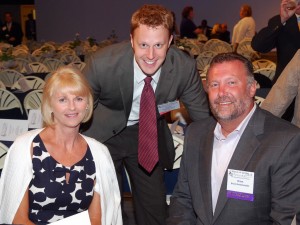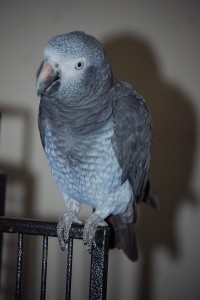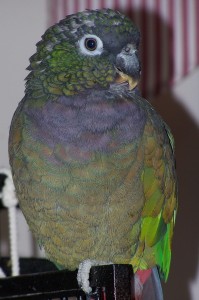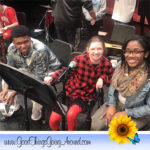Sometimes A Hug Is All You Need
Ft Mitchell Community Supports Family Of Michelle Mockbee
 This year’s annual Ft. Mitchell 4th of July parade will be a somber one, as the community reels from the loss of one of its own. In reaction to the recent death of Michelle Mockbee, Remke bigg’s has transformed its annual cook out into a fundraiser to benefit the family Michelle left behind when she was murdered at her workplace in late May.
This year’s annual Ft. Mitchell 4th of July parade will be a somber one, as the community reels from the loss of one of its own. In reaction to the recent death of Michelle Mockbee, Remke bigg’s has transformed its annual cook out into a fundraiser to benefit the family Michelle left behind when she was murdered at her workplace in late May.
Michelle leaves behind a husband and two young daughters. These funds will be used to help with care and education of the children.
“When something as tragic as this happens within our community, it’s important that we all rally to support those who have been affected,” Remke bigg’s community relations director Connie Flynn said. “Remke bigg’s understands the importance of spearheading this fundraiser and we look forward to celebrating the 4th of July and collecting for a great cause at the same time.”
Remke bigg’s will be holding their annual grill out at 2501 Dixie Highway in Ft. Mitchell. Festivities begin at 11:30AM. Remke bigg’s will be serving up the traditional hot dogs, chips and drinks.
Have A Jealous Or Stubborn Dog? Why I Can’t Help.
NOTE: I have a new pet behavior blog located at http://www.SoMuchPETential.com/blog. Thanks!
It happens SO often. When you ask pet owners about problems they are having with their pets, it boils down to their pet being dominant, jealous, dumb, stubborn, territorial, vicious, a pest, or just plain BAD.
Well, here’s the thing. When you tell me your dog is jealous, stubborn, or unmotivated I have absolutely no idea what it is  that your dog is actually ‘doing’ that causes you to see him as jealous, stubborn or unmotivated. When you tell me your bird is dominant or vicious, a number of different pictures go through my head – none of which could describe how your bird is behaving.
that your dog is actually ‘doing’ that causes you to see him as jealous, stubborn or unmotivated. When you tell me your bird is dominant or vicious, a number of different pictures go through my head – none of which could describe how your bird is behaving.
Descriptor words like jealous or stubborn really serve no value when it comes to behavior modification. They are adjectives that are better known as constructs in the science world.
In a recent course I took from Susan Friedman, Ph.D., she described it this way: “A construct is a kind of label that goes beyond a description of observed behaviors into the realm of hypothetical explanations for why an animal does what it does. While a construct may give a summary for a pattern of behavior, it serves as no help when it comes to developing a plan for changing the behavior with the most positive and least intrusive strategies.”
Susan went on to teach us that “constructs are nothing more than concepts that can’t be tested; constructs provide us with excuses to blame or worse get rid of the animal; constructs increase the use of ineffective training strategies and strategies based on punishment; constructs give us a false understanding of the problem when we’ve only given it a name; constructs foster self-fulfilling prophecies because you get what you expect; and constructs end our search for actual causes we can do something about.”
Just the other day someone was complaining to me about problems she was having with her dog who became ‘jealous’ when she got a boyfriend. “Baxter is a good dog. He’ll grow out of it,” was her response when I asked more questions.
Hmm. How about, instead of labeling her dog’s behaviors with constructs, she asks herself the following questions instead: What does this label ‘look’ like in terms of actual, observable behavior? Under what conditions does the behavior occur? What is the immediate outcome the behavior produces for my dog?
The answers will help her determine clearly defined behavior-change targets, antecedent predictors that set the behavior in motion, and what consequences maintain or strengthen the behavior. For example, instead of saying, “My dog is jealous,”, she could say, “When I sit on the couch with my boyfriend (antecedent), Baxter paws and bumps me (behavior) until I give her attention (consequence).”
Now I can see clearly what the behavior is that my friend wants to modify with an alternative behavior she wants to see more of instead. Now she can create a plan to make changes in the environment to set Baxter up for success such as teaching Baxter a behavior that is put on cue, and that is given when she sits on the couch with company.
And in the end, everyone succeeds.
Voices of Giving Awards Honored Those Who Give Back
It’s so neat to see people whose lives were touched in a meaningful way, and who, when times got better never forgot and choose to give back.
 Brian Brinkmoeller is one of those examples. He was a struggling single father to three curious and active girls who had a love for learning. On his own he wouldn’t have been able to afford the tuition for the Cathedral Child Development Center, a program of Children, Inc., but the organization was committed helping them no matter the circumstances. Now a successful business owner, Brian has remained steadfast to giving back to the agency that helped his family. In addition to serving on its board, he established the Monica Hughes Children’s Fund at the Greater Cincinnati Foundation to support families like his own. The Fund commemorates a young teacher at the Cathedral Center who died suddenly at age 32, and the very teacher who treated Brian and his girls as her own.
Brian Brinkmoeller is one of those examples. He was a struggling single father to three curious and active girls who had a love for learning. On his own he wouldn’t have been able to afford the tuition for the Cathedral Child Development Center, a program of Children, Inc., but the organization was committed helping them no matter the circumstances. Now a successful business owner, Brian has remained steadfast to giving back to the agency that helped his family. In addition to serving on its board, he established the Monica Hughes Children’s Fund at the Greater Cincinnati Foundation to support families like his own. The Fund commemorates a young teacher at the Cathedral Center who died suddenly at age 32, and the very teacher who treated Brian and his girls as her own.
“Brian’s thoughtful gift will keep giving, ensuring that Children, Inc. will always be able to serve kids regardless of their family’s financial situation,” said Jordan Huizenga, director of development for Children, Inc.
Brian and 23 other warm hearted philanthropists in our area were honored recently by the Greater Cincinnati Planned Giving Council with Voices of Giving Awards. This was the fourth year that I’ve helped them with the post even publicity and it is so inspiring to hear their stories.
The 14th annual Voices of Giving Awards were presented by PNC and were hosted by Local12 News Anchor John Lomax at CET. The program included featured speaker Lee Carter, co-chair of the 2012 World Choir Games United States, and a performance by the Cincinnati Girl Choir directed by Dr. Eva Floyd. The 2012 event was co-chaired by Mary Alice Koch (PNC Bank) and Chandra Mathews-Smith. Committee members included Sue Ellen Stuebing (CET), Carol Stevie (CISE), Tracy Monroe (Ronald McDonald House), Michelle Mancini (American Cancer Society), Telly McGaha (Redwood), Susan Kulick (Cincinnati Children’s Hospital Medical Center), Karen Kruer (NKU Foundation), Misty Griesinger (Association Connection), Jim Friedman (The Jewish Federation), Lori Asmus (Episcopal Retirement Homes), and Sally Alspaugh (Xavier University).
“Greater Cincinnati nonprofits making measurable impact in the communities where we live and work rely on generous donors to help them sustain their mission. Our Voices of Giving Awards is our way of saying ‘thanks’ to our philanthropists for being purposeful in helping to ensure the longevity of causes important to them,” said Lori Asmus, Voices of Giving committee member.
The Greater Cincinnati Planned Giving Council is a professional association for people whose work includes developing, marketing, and administering charitable planned gifts for non-profit institutions and a variety of other legal and financial settings.
2012 Voices of Giving honorees
To view all of the photos from the event, please click here.
(Note: photo is of Cindy and Brian Brinkmoeller with Jordan Huizenga in the back)
Using Systematic Desensitization To Curb Pet Aggression
NOTE: I have a new pet behavior blog located at http://www.SoMuchPETential.com/blog. Thanks!
This is an inside look at how I used behavior analysis and systematic desensitization to work through a very serious behavior issue in my house. NOTE: this article was written for Hyde Park Living over a year ago.
It all began about six week s ago. Until then, my birds always had free access to their environment with their cage doors open whenever I’ve been at home. For the most part they’ve stayed on their own cages either napping or keeping busy with things I’ve given them; or Barnaby would fly onto his play cage in the other room.
s ago. Until then, my birds always had free access to their environment with their cage doors open whenever I’ve been at home. For the most part they’ve stayed on their own cages either napping or keeping busy with things I’ve given them; or Barnaby would fly onto his play cage in the other room.
And that is why, when I came upstairs to hear ‘Mommy here!’ coming from down the hall I initially thought it was just another day…until I saw Dreyfuss atop Barnaby’s cage. Dreyfuss chased Barnaby off his cage and that one bad decision set everything in motion.
Just the sight of Dreyfuss transformed Barnaby, my gentle teddy bear, into pure rage. (aggression not to me, only directed toward Dreyfuss) Barnaby flew at her like a hawk would fly after prey. I’ve never seen him behave like that. That day I kept both birds separated, and then ‘I’ made a bad decision. Barnaby really wanted back into his room and I thought I could allow him open cage time if Dreyfuss was in her cage with the door closed. Sadly, in a split second, Dreyfuss climbed the bars of her cage and Barnaby dove in, tearing Dreyfuss’s toe open.
OK, there was no more room for bad decisions. I had to come up with a game plan fast. Knowing that ‘positive practice makes perfect’ when it comes to any behavior, my short- term goal had to be preventing any situations that would create opportunities for Barnaby’s flying at Dreyfuss behavior. Every moment of every day that passes without Barnaby flying at Dreyfuss is a practice-free victory.
Remember those ABCs of behavior I’ve been talking about? Well, in this case the antecedents that predict Barnaby’s flying behavior included Dreyfuss being outside of her cage – whether sitting on her door, on top of her cage, or on my hand when Barnaby was within close proximity of less than six feet apart. Actually, when I analyzed it closely, there is a chain of ABCs. Those antecedents predicted Barnaby’s feathers to stand erect, his body to become taught, and his eyes to be pinned while being transfixed on Dreyfuss.
The ABC formula for this would be: (background scenario is that the birds are within six or seven feet from each other and usually in their own room) 1. Antecedent – Dreyfuss is outside her cage; Behavior – Barnaby’s feathers stand erect, his body becomes taught, and his eyes pin while being transfixed on Dreyfuss; Consequence – Dreyfuss stays where she is at. 2.) Antecedent – Dreyfuss stays where she is at; Behavior – Barnaby flies at her; Consequence – Dreyfuss gets knocked to the ground, injured or fights back.
As you can see, Barnaby clearly exhibited non aggressive body language that did not achieve a desired consequence, which escalated things to the aggressive flying behavior. By looking at the behavior in the context of its environment, the key to success here was to interrupt that chain. I had to work to 1) reduce or prevent circumstances as much as possible that would cause Barnaby to exhibit that body language to begin with and 2) if Barnaby did show any of that body language, I needed to empower him by allowing him to have a positive consequence from that nonaggressive behavior BEFORE it escalated.
The key to all of this was my being consistently and extremely aware at ALL times of Barnaby’s body language.
In the beginning when tension was at the extreme (when just the sight of Dreyfuss would set things in motion), I kept the two birds either in their cages or as far apart as they needed to be in order for Barnaby to be relaxed. And I never missed an opportunity to reinforce calm behavior with attention and/or food. (If they were out of their cages, one was in the tv room.)
Slowly I was able to carry Barnaby closer to Dreyfuss all the while going only at a pace that Barnaby’s body language told me he was comfortable with. As I walked with him on my arm, I continued to divert his attention with a lot of my attention. The second that I saw any sign of tensing up in his body, that was my cue to back up and start again. Scientifically this is called systematic desensitization, when you gradually expose an animal to a feared stimulus in small, incremental steps, never crossing the threshold into tense body language.
After some days when Barnaby was showing calm body language (not fixating on Dreyfuss, feathers down) while in the same room as Dreyfuss – in another area of the house – it was time to start working with them in their own room where the flying behavior is most likely to occur. Always in prevention mode, I let Barnaby out of his cage first and then gave him a few seeds before taking a step toward Dreyfuss’ door. I never took my eyes off Barnaby. If I noticed even one of those precursor behaviors just starting, I backed away from Dreyfuss’ cage. Again, slowly we got to where I opened her door and got her out. Then, as soon as she was out, I held her at arm’s length while giving Barnaby more attention for showing calm body language. Next, when we got to where Barnaby would step up on my other arm while I was holding Dreyfuss, I ignored her while talking to Barnaby.
Over time and positive repetitions, because I used only positive reinforcement while allowing Barnaby the power to make his own decisions, he no longer pins his eyes or gets taught when I let Dreyfuss out of her cage or pick her up and I can walk out of their room for short periods of time, while still in range.
I’m not sure if there will ever come a day when I can leave their cage doors open for hours at a time again (Barnaby does still need his exercise flying laps after all), but it sure is nice having peace again in our house.
































































